 |
 |
 |
| Bert … James Cagney |
Ann … Joan Blondell |
Dan … Louis Calhern |
 |
 |
 |
| Rupert … Guy Kibbee |
Helen … Noel Francis |
Reynolds … Ray Milland |
Proof That It’s Pre-Code
- This may take a while to load, but I think you’ll understand:


- Also, more robbery, cheating, lying, ogling and eyebrow waggles than anyone can shake a stick at.
Blonde Crazy: And Slap Happy
Rarely these days do I get to discuss a film as demented as Blonde Crazy. This Warner Brothers feature starring James Cagney and Joan Blondell has everything lascivious about Depression-era film making and moralizing in one convenient package. If that opening gallery didn’t sell you, hold onto your butts.
We begin with a hotel bellboy named Bert who has a detailed scrapbook full of con artists and the scams they’ve run. He plans on joining their ranks and finds a hotel is an ideal place for him to start. Lots of simple coworkers, gullible guests, and compliant maids. He expects a little compliance from Ann, the beautiful blonde he gets a job (after furiously scoping out her rear end to ensure all is in order), but finds himself unceremoniously refused.

The con is on.
Ann isn’t your average girl, seeing as how Bert’s demands for romantic indulgence are always reciprocated with a nice slap. However, she’s game for the work of con artists, and they’re off to fleece the first sucker who comes their way. Since Joan Blondell is around, that must mean that just as she did in Havana Widows and Footlight Parade, it’s time to make a sucker out of Guy Kibbee.
After stuffing pearls down the back of his pants and making off with $5,000 after they have a fake cop threaten to expose their fake affair to his presumably real wife, Bert and Ann are off to Chicago to step up their game. Bert’s one of those egotistically self assured men who always thinks he’s the smartest man in the room, which is going to get him into trouble.
He’s the same way with Ann, and no matter how many times she calls him out for being childish, he is more than happy to waggle his eyebrows one more time. Luckily, Bert gets slapped. A lot.




Bert teams up with a conman named Dan to purchase some counterfeit bills with the use of the scam money they’d acquired so far. Feeling slighted, he also begins to turn his attentions from Ann and towards the more receptive Helen. Believe it or not, this turns out to be part of a larger con that sees Dan running off with Bert and Ann’s money and Bert burning with anger at being shown up.
To cover up his loss to Ann, Bert arranges a heist that leaves two parties believing one another has an expensive bracelet and a pawn broker who reluctantly gives up a third of the bracelet’s price. For his stinginess, Bert slaps the man in his face with a wad of cash.
This is important to note because of Ann’s reaction. She’s the voice of reason and kindness for most of the picture, and she’s mortified when she discovered that Bert sunk low enough to steal. Mind you, that comes from a conman, which gives you a clue to this film’s approach to morality.
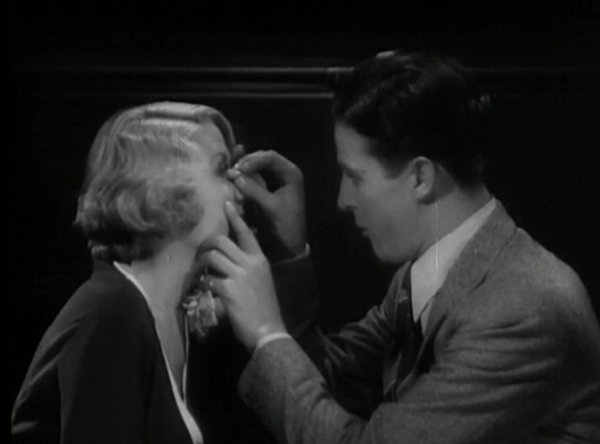
A rival appears! Uh, once he gets that out of her eye.
The conman knows who he or she is going after, and they know the stakes of what they’re doing. In the circumstances of the early 30s, it’s understandable that such people could feel completely justified in their actions just by observing the national news. After the market crash, the purveyors of stocks were seen along the same lines as fraudsters, selling the masses of America phony dreams for empty pocketbooks. Con artistry is merely a more honest extrapolation; at least when they take you, they make no extravagant promises afterward.
This plays into the next wrench in the plot, when a chance encounter on the train leads Ann into the lap (and eventual arms) of a stock trader named Reynolds. While she and Bert plot revenge on Dan, she also begins to fall for this new man. Bert, unable to grasp at the artistic merits and book smarts of his rival, loses his chance to step up and tell Ann how he really feels about her. After another successful con, she marries Reynolds, and Bert embarks on a global trek to try and forget how he messed up the whole thing.
There’s one more act to go, but I won’t spoil too much for you. Just remember that in the films of the early 30s, bank managers and stock brokers act with the same moral paucity as the Nazis would in films a decade from then. Ann and Bert rekindle their romance, and, while Bert ends up in prison, we know that he’s finally learned the difference between being an immature brat and a cagier… well, brat.

My wife loved Blondell’s wedding gown. That is some nice work.
Cagney and Blondell were discovered by Hollywood together on Broadway in the play “Penny Arcade”, and both were brought there to star in its adaptation, Sinner’s Paradise. They worked together in seven films, and have an easygoing, playful relationship with one another that shines through the material; even with all of the slapping and romantic double crosses, there’s no doubt that when these two are put in a room together, sparks will fly.
Their interplay is also indicative of the era. When Blondell dumps the unreliable Bert for the upper crust Reynolds, its hard not to agree with her choice: while Bert has affection, he’s flighty and demanding. When Reynolds turns out to be a criminal along the same lines as Bert and Ann– embezzling rather than grfiting– it’s up to Bert to help him out and save face. Unfortunately, stock brokers have no honor. In fact, their higher education and snooty manners are just part of their own long con on the poor citizens of the country.
Ann and Bert learn this too late, but their discovery and grit will cuckold Reynolds and let Bert endure. While it’s not revenge, it’s justice. And that’s what people need.
Gallery
Here are some extra screenshots I took.
Here are some more screen shots from the Warner Archive release of Forbidden Hollywood, Volume 8. Click for big!
Trivia & Links
- Jeff at the Movie Morlocks talks about the Cagney/Blondell chemistry at length, as well as the history of their relationship. Lots of great publicity stills and lobby cards contained within.
- Krell Laboratories took many of the things I’d been planning to say about the movie right out of my mouth.
As he and Ann move up the social ladder, the scams become indistinguishable from business, such that the worst grifter in the movie is the respectable businessman. In some ways, the con man is the archetypal American, and this film knows that in its bones. This is cynical, I suppose, but this movie was made at a time when capitalism’s mask was off and the wormy underside was on public display. And yet, this film’s glittering high life is a lure, too. The means are repulsive, but the end is glory. In some ways, this kind of critique pulls that moralizing, tacked-on ending back into the film as a necessity. Bert is never truly happy when he’s a grifter. Not really. Neither is Ann. It’s only when they both have the grift stripped away from them that they discover their own happiness, and only when the system has utterly failed them.

One of the better jokes in the film is that sign behind the quartet of grifters.
- Judy at Movie Classics talks about how she’s come to like the film’s ending, and she also has some interesting trivia about the film’s title:
Several of Cagney’s early films had their names changed to sound sexier – with Penny Arcade becoming Sinners’ Holiday and The Steel Highway being renamed Other Men’s Women, despite the fact that only one “other man’s woman” is involved. The same sort of retitling went on with Blonde Crazy, which was originally supposed to be called Larceny Lane – and even shown under that title to a few critics. The original title is in some ways more appropriate, since Cagney’s character, Bert, is far more mad about organising con tricks and making money than he is about women. He’s also only really crazy about one blonde, even if he makes eyes at a few more. However, I think the frothy title does give more of a flavour of the silly, fun atmosphere for much of the film.
- Gene at 11 East 14th Street talks about Joan Blondell’s history on Broadway and how she was shot in different films. Lots of screenshots of lots of Blondell here for ya.

Did someone want screenshots of Blondell? I can’t imagine why.
- Mordaunt Hall could smell the applesauce when it came to the film’s tidy ending:
It is amusing so long as the crooks are outwitting each other, or, being outwitted, but the introduction of the marriage of a shady blonde to a young broker of good family and the subsequent declaration of love between the same girl and Bert Harris (Mr. Cagney), who starts as a bootlegging and blackmailing bell boy and winds up in the hands of the law, are a little too much on the dime novel order.
- Erik Lundegaard brings up a couple of good points about the film’s staging and how foreign much of its dialogue seems to us:
When the film was made, in 1931, sound was still relatively new and it was still freezing the camera. There are so many early scenes in a hotel linen closet that viewers may get claustrophobic. We also get the slang of the day: “mugged” for arrested; “Everything’s jake”; “I could eat the hip off a horse!” The film is almost as interesting for its historical perspective as for its storyline. Einstein is mentioned, so we know his smarts had already permeated the general culture. More astounding is a scam from a fellow grifter: selling swastika charms. The Nazis really put the kibosh on that symbol.

Chemistry so good it sizzles.
- The incurable Movie Diva uses the film to discuss James Cagney’s screen persona, and how that reflected the real man in comparison to the other popular ‘gangster’ actors of the era:
Unlike Robinson, a thoughtful “Method” type actor who used his salary to amass a famous art collection, or Bogart, an upper middle class WASP who spent his career playing against type, Cagney projected heightened facets of his own personality. He had grown up in a poor NYC neighborhood, a tough and wily street brawler. One close boyhood friend died in the electric chair for murdering a cop, and plenty of his other pals ended up in Sing-Sing.
Primary Sources
Thanks to Lantern, there are hundreds of issues of fan magazine and industry journals from the pre-Code era available for free. Here are some related articles; click on the ‘View Full Sized Image’ in the bottom right to view!
Awards, Accolades & Availability
- This film appeared in the Wikipedia List of Pre-Code Films.
- This film is available in the 8th Forbidden Hollywood collection from Warner Archive, which also includes Hi, Nellie!, Strangers May Kiss, and Dark Hazard. You can get it from Warner Archive directly or over at Amazon. Thanks to Warner Archive for providing a review copy of the set.
 |
Comment below or join our email subscription list on the sidebar!Home | All of Our Reviews | What is Pre-Code? |

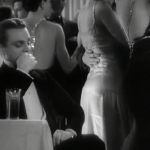



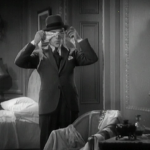












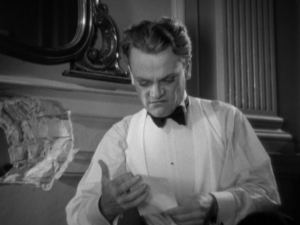

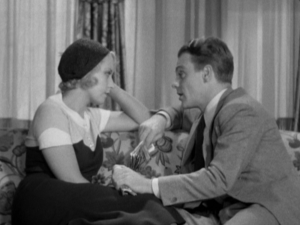









10 Comments
Judy · September 20, 2013 at 2:57 pm
I really fail to understand why this Cagney classic hasn’t had a DVD release as yet – it did get a VHS release, but should really have been in one of the Forbidden Hollywood DVD sets. I hadn’t realised it is on Warner Archive streaming (which we can’t get in the UK) – but maybe that gives hope that it will be put on WA DVD too. Anyway, ‘Blonde Crazy’ is great fun and I love your gif of Guy Kibbee with Blondell! Thanks so much for linking to me, Danny, and I enjoyed your review a lot.
Danny · September 20, 2013 at 3:42 pm
Thanks Judy! I don’t want to spread conspiracy theories, but I imagine Warner Archive made this a streaming exclusive to help get people interested in their service. It’s definitely one of the more interesting pieces of the period to people who love the period, so having an exclusive or two there doesn’t hurt. But I also know stuff they’d had on streaming exclusively for a bit has gotten rumblings of DVD releases too, so hopefully we’ll be able to own this one on home video soon.
Andrew · September 20, 2013 at 3:14 pm
Even though they made seven films together, in most of them they’re not really featured as a team the way they are here. I sure wish they had made more together like this. If they had, they’d probably be just as celebrated as Bogie and Bacall or Hepburn and Tracy. The chemistry is obviously there, it just didn’t get enough chances to be properly showcased. And while I love them both, I particularly adore Joan Blondell and wish she were as well-remembered and loved today as Mr. Cagney is.
Danny · September 20, 2013 at 3:40 pm
They’re also romantically paired in Footlight Parade, but unfortunately Joan is saddled with the ‘good girl who has to wait for her guy’ trope. I agree that there needed to be more team ups like this, as these two are firecrackers together.
David Inman · September 21, 2013 at 8:29 am
This is one of my favorite Cagney, and since he’s one of my favorite actors that’s saying a lot. It’s also one of those movies that GIFs were invented for. Nicely done.
Danny · September 21, 2013 at 2:31 pm
I actually took more .gifs, but I was afraid with too many the page wouldn’t load if I put them all on. This one is just a lot of fun.
JennyG · September 24, 2013 at 3:14 pm
I plan on incorporating the derogatory and dismissive “smackoff” into my vocabulary. And your wife is right: Blondell’s wedding dress is the most gorgeous thing.
Danny · September 24, 2013 at 7:33 pm
Luckily my wife doesn’t need to be told she’s right, she already knows it. 😉
Comments are closed.